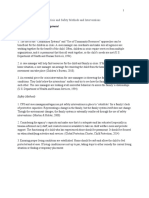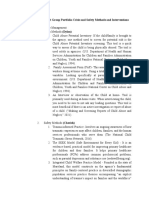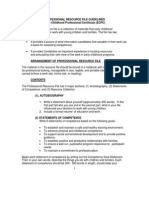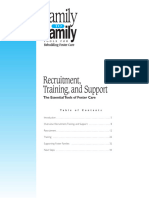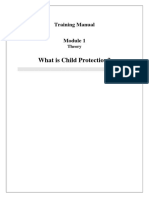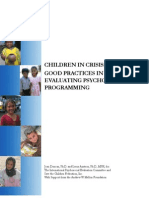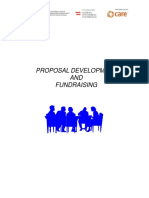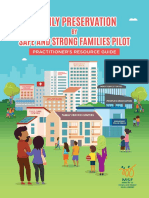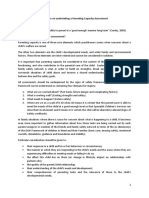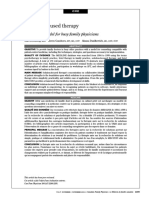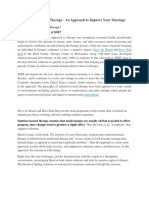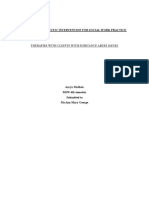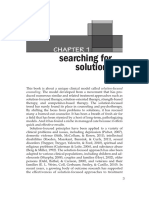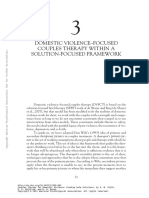Framework PR Tools
Uploaded by
Andrew Myles-WrightFramework PR Tools
Uploaded by
Andrew Myles-WrightStrengthening families | Protecting children
Framework for practice
Practice tools and
processes
The practice tools within this document (with the exception of the Collaborative Assessment and Planning
Framework, the Three Houses tool and the Structured Decision Making System), have been developed by and
are copyrighted by Sonja Parker. For further information, please contact sonja.parker@iinet.net.au,
www.spconsultancy.com.au
The Collaborative Assessment and Planning Framework was developed by and is copyrighted by Phil Decter
and Sonja Parker.
The Three Houses tool was developed by and is copyrighted by Nicki Weld and Maggie Greening.
Structured Decision Making ® and SDM® are registered in the US Patent and Trademark Office. SDM® is
copyrighted by the Children’s Research Center of the National Council on Crime and Delinquency, all rights
reserved.
Department of Communities, Child Safety and Disability Services
GPO Box 806
Brisbane Qld 4001
www.communities.qld.gov.au
Contents
Introduction ....................................................................................................... 2
Solution-focused inquiry ............................................................................... 4
Collaborative Assessment and Planning Framework ............................ 6
The Three Houses©........................................................................................... 8
The Family Roadmap ....................................................................................... 9
Structured Decision Making® system ...................................................... 10
The Future House............................................................................................ 11
Circles of Safety and Support ..................................................................... 12
The Safety House ............................................................................................ 13
The Immediate Story ..................................................................................... 14
Foster carer profiles ....................................................................................... 15
The Safe Contact Tool .................................................................................... 16
Child- and family-centred safety plans.................................................... 17
Collaborative action planning tool ........................................................... 18
Processes to support the practice ............................................................ 20
Introduction
The Strengthening Families Protecting Children Framework for Practice is a strengths-based,
safety-oriented practice framework that guides child protection practice in Queensland. A
strengths-based, safety-oriented framework is one that is designed to help all the key
stakeholders involved with a child — the parents, extended family, community, child
protection workers, supervisors and managers, non-government organisations (NGOs),
partners, lawyers, magistrates, and even the child him-/herself — keep a clear focus on
assessing and enhancing child safety at all points in the child protection process.
The framework begins with a commitment to always viewing families in context and
constantly eliciting families’ strengths, knowledge and wisdom throughout our work
together. The process is organised around a rigorous and balanced assessment and
planning process that is developed collaboratively with children, their families and their
communities. This assessment process provides the focus for families, professionals and
helping networks to work together to develop and implement detailed plans that describe
the day-to-day actions everyone will take to ensure and enhance children’s safety,
belonging and wellbeing.
This document is the second in a series about this framework. The Foundational Elements
document introduces the background and underpinning of the framework and includes
descriptions of the best hopes, values, principles, knowledge and core skill areas
associated with the approach. These elements, particularly the core skills, are
operationalised by an array of practice tools and processes that workers can use in their
everyday work with families. This document introduces these core practice tools and
processes, implemented in other jurisdictions, and identified as effective and able to be
built on.
The Framework for Practice explicitly views child protection as a change process and child
protection workers as facilitators and change agents. What comes in the pages that follow
are some of the ‘tools of the trade’ for this work. Each of these tools helps to make easier
some of the difficult aspects of engagement, assessment, planning and process. They help
to provide a bridge from the values and principles to the day-to-day work with families.
Some of these tools are, or will become, part of key organisational processes that will be
undertaken with every family the department works with. Others will be used at worker and
supervisor discretion when they are needed or when workers and families feel they will be
most helpful.
All of these tools are designed to deepen practice; to make it more collaborative and
participatory; to ensure that practice is robust and rigorous; to create action steps and
plans that allow children, young people and families to thrive; and to ultimately work more
effectively in seeking to strengthen families and to secure enduring child safety, belonging
and wellbeing.
2 Strengthening families | Protecting children | Framework for practice
Core skills Practice tools and processes
Engagement: the development • Solution-focused inquiry
of effective working • The Three Houses
relationships
• The Family Roadmap
• The Future House
• The Immediate Story
• Foster carer profile
Assessment: critical reflection • Collaborative Assessment and
and robust decision making at Planning Framework
key decision points • Structured Decision Making
(SDM) system
• The Safe Contact Tool
Planning: collaborative • Circles of Safety and Support
processes for building rigorous • The Safety House
change plans
• The Safety Planning Framework
• Child- and family-centred safety
plans
Process: focus on processes • Appreciative inquiry
that support and reinforce the • Enhanced intake
practice
• Regular group supervision and
case consultation
• Strengthened family group
meetings
• Enhanced partnerships with
NGOs, partner agencies and the
courts
• Continuous quality improvement
efforts
Practice tools and processes 3
Solution-focused inquiry
Originating with the work of Steve DeShazer and Insoo Kim Berg at the Milwaukee Brief
Treatment Center, solution-focused inquiry (SFI) is a ‘questioning’ approach or interviewing
practice based on a simple idea with profound ramifications — that ‘the areas people pay
attention to grow’. SFI provides strategies for workers to efficiently and effectively facilitate
a change process by using questions to elicit a vision for change. SFI assumes the family is
competent to change should they decide to do so.
SFI supports the development of a constructive working relationship with families by
eliciting this vision for change and then focusing on ‘actions of protection’ and strengths in
as rigorous a way as we focus on the ‘risk’ or ‘danger’. Whilst there is no particular formula,
workers will learn when to use a particular type of solution-focused question to elicit the
information they need or to facilitate the change intervention.
Types of questions include:
1. Miracle questions are used to help children, young people and families create goals and
vision what they will be doing differently in their desired future.
Let us imagine it is six months in the future from now and all the problems that
brought us into your life are totally resolved. What would it look like? What steps
would you have had to take to get there?
2. Exception questions uncover instances when the problem could have occurred but
did not, and help obtain a balanced picture of the family, creating a vision that change
is possible.
Can you tell me about a time when this problem was not happening? When was that?
How did you make that happen? What kind of difference did that make for your child?
3. Scaling questions help create discussion and understanding of danger and safety. It is
not the number that is important, but the conversation that follows the scaling process.
Scaling questions can also help elicit ‘next steps’ to change.
On a scale of zero to 10, where zero being your child is not safe and will be
immediately hurt, and 10 being your child is now completely safe, where would you
say things are? What are you already doing or what is already in place that has you
this high on the scale? What would need to happen to bring things up by one?
4 Strengthening families | Protecting children | Framework for practice
4. Position/relationship questions help to see a situation through the eyes of other
people, and can be very enlightening when imagining how other people, such as their
child, are seeing or experiencing things.
I notice you scale yourself as a nine on a scale of 10, indicating you are solidly in
recovery from using drugs. If your baby could talk, where do you think she would rate
you? What do you think would get her to that number? What would her worries be,
if any?
5. Coping questions acknowledge difficulty and help people discover skills they possess
and supports that helped them survive challenges and difficulties.
I imagine that raising five children under the age of six on your own must keep you
very busy. How do you manage day after day? What helps you to keep going?
6. Detail questions are useful to elicit details of goals and help to operationalise the
change process in small steps of actions and behaviours.
• What specifically are you going to do?
• When are you going to do it?
• How are you going to do it?
• Is it ‘doable’?
• Who will notice that you are doing it?
• What difference do you think it will make?
• On a scale of zero to 10, if 10 is the highest and zero is the lowest, how confident are
you that you will do it?
Practice tools and processes 5
Collaborative assessment and planning framework
The collaborative assessment and planning framework1 is a tool that enables a balanced
and comprehensive child protection assessment to be undertaken with families and their
networks. The process of case ‘mapping’ involves the use of the collaborative assessment
and planning framework to organise all the key information known about a child and family
at any given time into key domains relevant to the goal of enhancing ongoing safety,
belonging and wellbeing for the children. The framework is used collaboratively with all the
significant people involved with a child — the parents, the extended family, child protection
workers, supervisors and managers, lawyers, magistrates, other professionals, and even
the child him-/herself — and is used from the first point of contact with a family right
through until case closure. The collaborative assessment and planning framework is also
used in supervision and case consultations to bring clarity and focus to casework and
case planning, and is a critical step in the development of rigorous and long-term
family-centred plans.
Four domains of inquiry
The collaborative assessment and planning framework is organised around four key
questions2:
1. What has happened/is happening within the family that worries us? (Harm and
complicating factors.)
2. What is going well within the family? (Protection and belonging, and strengths.)
3. Safety and wellbeing scale: On a scale of zero to 10, how safe is it for the children in the
care of the family at this point in time?
4. What needs to happen for the children to be safe and well in the future? (Identifying
future worries, collaborative goals and action steps to achieve these goals.)
As these four domains illustrate, the collaborative assessment and planning framework
focuses on understanding what has happened and what is happening within a family in
relation to the safety, belonging and wellbeing of the children, and then working together to
plan for the future. Including all four key questions or domains of inquiry ensures a
balanced assessment focusing on the worries as well as what is going well, that the safety
judgment is made explicit as part of the assessment and planning process, and that the
focus is on moving forward from the past toward building future safety and wellbeing for the
children.
1 The assessment and planning framework has been adapted from the Signs of Safety risk assessment and planning framework (Turnell &
Edwards, 1999; The Consultation and Information Sharing Framework (Lohrbach, 2000); and the Massachusetts Safety Mapping Framework
(Chin, Decter, Madsen and Vogel, 2010).
2 Adapted from the four domains of inquiry within the Signs of Safety approach (Turnell & Edwards, 1999; Turnell & Parker, 2009).
6 Strengthening families | Protecting children | Framework for practice
Collaborative assessment and planning framework
Practice tools and processes 7
The Three Houses©
Hearing the voices of children, young people and family members
Developed in New Zealand by Nicki Weld and Maggie Greening, the Three Houses is a
practical visual tool to help parents and families identify their own strengths, hopes,
dreams, and vulnerabilities. The tool was designed to be used by child protection
practitioners in everyday work situations with families to understand the views of children,
young people and family members. It also assists them to understand and participate in
child protection assessment and planning processes.
A simplified version was developed for use with children and young people (and can also
be used with adults and in family conferences). Using drawings of three houses (or any
other images that the child or young person relates to), the tool explores the child’s or
young person’s worries about their lives, the good things or positive things that are
happening in their lives, and their hopes and dreams for the future.
8 Strengthening families | Protecting children | Framework for practice
The Family Roadmap
A visual, family-centred assessment and planning process
Eliciting the views of parents and family members can be a difficult task for child protection
workers, particularly when they may be angry or scared, may have little trust in
professionals and may feel anxious about the possible consequences of speaking openly.
The family roadmap is a solution-focused, strengths-based and family-centred process
designed to help workers, parents and family members work together more effectively in
talking about the family’s current situation, and mapping a way forward to future safety,
belonging and wellbeing for the children. The family roadmap is a visual process that takes
place up on a wall, on a large table or on the floor, and family members are actively
involved in writing and creating their family roadmap.
The family roadmap process starts by inviting the parent or family members to describe
what life is like when things are at their best for their family, and then moves to a
description of what life is like when things are at their worst. This provides the opportunity
to acknowledge that every parent and every family has difficult and challenging times when
they are far from their best. A path or scale is then created between these two positions.
This enables the family to describe where they see themselves at this point (relative to life
at its best or worst), what has happened that has enabled them to do as well as they are
(wherever they are on the path) and what they would need to do to move closer toward their
vision of life at its best. The family roadmap process also identifies who has supported or
who could support the family in achieving this and explores the obstacles or roadblocks
that the family has already dealt with and may deal with in the future.
Practice tools and processes 9
Structured Decision Making® system
Bringing the art and science of child protection practice together
There are regular and predictable key decisions that need to be considered in almost every
child protection case. The structured Structured Decision Making® (SDM) system,
developed and refined by the National Council on Crime and Delinquency’s Children’s
Research Center (CRC), brings the best of child protection research and aggregate data into
a set of decision support tools. These tools are used as a guide by workers to support
practice at key decision points, providing consistency of decision making and congruence
with research, best practice and organisational policy.
In particular, SDM helps to highlight the differences between the concepts of harm and risk.
Immediate harm is focused on situations that could imminently hurt a child and is assessed
using the safety assessment tool. Risk is focused on the likelihood or probability of harm
occurring in the future, an assessment made with an actuarial risk tool called the family risk
evaluation (FRE).
The CRC has worked to integrate the SDM system with this Framework for Practice. This
ensures the SDM tools are not misunderstood as forms that need to be simply filled out.
The foundational elements of the Framework for Practice (such as the values and principles)
underpin the approach and should be present in a practitioner’s work at all points. The core
practices (such as the collaborative assessment and planning framework, Three Houses and
others) give practitioners methods for bringing collaboration alive in their day-to-day
practice and can be used at any point in their work with families. The SDM assessments
help to ensure the framework continues to be guided by valid and reliable tools at the key
decision points. Together the overall approach helps to bring the art and science of the field
together and create the best outcomes for children, young people and families.
Linking SDM and the core tools and practices
10 Strengthening families | Protecting children | Framework for practice
The Future House
A tool for eliciting parents’ and family’s visions for the future
The future house tool is a simplified version of the family roadmap process and focuses on
eliciting and understanding parents’ and family members’ visions for the future safety,
belonging and wellbeing of the children and their ideas about steps toward achieving this
vision. Eliciting and understanding the parents’ views is a necessary first step in working
with families to develop a joint vision — between caregivers, children, their network and
professionals — of enduring safety, belonging and wellbeing for the children.
This solution-focused and strengths-based process uses a drawing of a ‘future house’ to
represent what would be happening in the future, if the children were safe and well in
relation to the identified dangers or concerns. Solution-focused questions are used to invite
family members to describe in detail what would be happening within their family and their
home if the problems that led to the involvement of the child protection agency had been
addressed and resolved. The person’s answers to these questions are recorded in the
future house using words, pictures, or a combination of both.
The Future House
Practice tools and processes 11
Circles of Safety and Support
Involving a safety and support network for the family
A core component of a strengths-based, safety-oriented practice approach is the
development or strengthening of the family’s safety and support network. The safety and
support network is made up of people who will support the parents to develop and
maintain a safety plan for the children, and who can continue to play this role long after
professionals have stopped working with the family. The safety and support network
provides support to the parents and safety for the children, and in some situations, safety
for the adult whose behaviour we are worried about.
The circles of safety and support tool, inspired by the concentric circles used by Susie Essex
in the Words and Pictures method and the circles concept from the Protective Behaviours
approach, was designed to help family members identify people for the family’s safety and
support network. This tool also helps workers have conversations with family members
about why a safety and support network is necessary, about the role the network can play,
and the process of assessing who would be the most appropriate people to participate in
this network.
“Circles
Circles of safety of
Safety
and support tool&
Support”
Tool
Name/photo/drawing � Who are the people who
of family members support you the most?
� Who do the children feel
most connected to?
� Who already knows
everything that happened?
� Who are the people who
support you a little?
� Who do the children feel
� Who are the people who you don’t ask for support from
some connection with?
but maybe could in the future?
� Who already knows a little
� Who are the people who don’t support you and maybe
bit about the hard things
make things harder for you and your family?
you’ve been dealing with?
� Who are the people in your life who don’t know anything
about the hard things you’ve been dealing with?
12 Strengthening families | Protecting children | Framework for practice
The Safety House
A tool for involving children and young people in safety planning
The safety house is a practical, visual tool designed to help workers have conversations
with children and young people about long-term planning for safety, belonging and
wellbeing. It helps elicit the views of children and young people about what needs to
happen to ensure they are safe and well, in situations where they may have previously been
harmed or were at risk of being harmed.
Case example for nine-year-old child
Practice tools and processes 13
The Immediate Story
Providing a simple, clear explanation to the child and others about the
reason for child protection intervention
Even with the best of intentions, our child protection processes, particularly when they
involve the removal of a child, can be potentially traumatising for children and parents.
A clear and simple explanation is essential to help mitigate any unintended harm or trauma
from our interventions. The immediate story is a clear, simply-worded story that is
developed by the worker and provided to the child at the point when the child is removed
from the parents’ care (or as soon as possible afterwards), or when work is undertaken with
the family to create an immediate safety plan that involves significant changes for the family.
The immediate story provides a simple explanation to the child and family members about
the reason for the child protection intervention, about what is happening now or has just
happened (for example, the child is being removed from their parents’ care and going to
stay with other family members or foster carers, or Dad is going to stay somewhere else and
Grandma is going to move in), and what is going to happen next in the collaborative
planning process. The immediate story also provides an immediate explanation to parents,
carers and family members so they are able to reinforce this explanation and provide
informed comfort and support to the child.
Case example (for a five-year-old child who is being taken into care)
14 Strengthening families | Protecting children | Framework for practice
Foster carer profiles 3
Building relationships between foster carers and parents
When children and young people are placed in out-of-home care, they can become scared,
confused and distressed — even when the removal from their parents was necessary and in
their best interest. Developing a good working relationship between the child’s family and
the foster carers can positively impact children’s sense of safety, belonging and wellbeing
during their time in care; can help ensure both the quantity and the quality of contact visits;
can facilitate collaborative planning and help to ensure that everyone is working toward
shared goals; and, ultimately, can assist with successful reunification efforts.
A foster carer profile, such as the example below, can be used to support parents and
carers to start to build a relationship4. The profile is first developed with the carers and is
then shared with parents in order to help parents understand a little about the people who
are caring for their child.
After the foster carer profile is shared with the family, it creates the possibility for family
members to then share some information about themselves and their child with the foster
carers. This might take the form of a profile, a letter, photographs, a phone call or a video
— whatever the parents are most comfortable with. It might include detailed information
about the child’s likes or dislikes — or more global information about the family and their
hopes for the future.
Example: Foster carer profile When carers and family members can make
this connection right from the start it can
become easier for families and foster carers
to work together. This might take a variety
of forms: Carers and parents might share
information about the child via the worker
or agency; foster carers might supervise
contact visits, either in their home, within
the family home or a neutral venue; foster
carers and parents may participate together
in family meetings; and foster carers can
act as mentors to the parents and become
part of the family’s ongoing support
network.
3 Based on the Te Whanau Nei process, developed by Jill Devlin from Open Home Foundation, New Zealand.
4 As well as helping children to understand who they will be staying with, as discussed in the ‘Immediate Story’.
Practice tools and processes 15
The Safe Contact Tool
Developing collaborative and transparent contact plans
When a child is removed from the care of their parents and placed in kinship care or out-of-
home care, establishing safe and meaningful contact between the children and their
parents is one of the most critical and immediate issues that the child protection agency
must deal with. It is also usually one of the first issues that children and parents want to
focus on. The safe contact tool has been designed to engage all of the significant people in
the children’s lives, including the children if they are old enough, in decision making and
planning to ensure that contact between the children and their family is safe, and is regular
and frequent enough that it enables children to maintain their connections with their family,
community and culture. The first version of the safe contact tool focuses on establishing
contact and the second version focuses on increasing contact.
The safe contact tool is designed to be used with children, families, their networks and
carers over the entire period of working with a family to ensure that decision making about
contact continues to be collaborative, transparent and centred on safety, belonging and
wellbeing.
16 Strengthening families | Protecting children | Framework for practice
Child- and family-centred safety plans
Detailed action plans to support children’s long term safety,
belonging and wellbeing.
A critical component of a strengths-based, safety-oriented practice approach is the
collaborative development of child- and family-centred safety plans5. These plans can be
created as immediate safety plans as part of the initial assessment process, or following
changed circumstances in a family that may be a threat to the child, and are supported by
the SDM Safety Assessment. The plans can also be long-term action plans that are
developed with families and networks to build enough safety, belonging and wellbeing to
return a child home and/or close a case. At whatever point the plan is being developed, the
process of creating child- and family-centred safety plans involves all the significant people
in a child or young person’s life — the parents, extended family, carers, friends and
professionals — working together to create a detailed plan that addresses the concerns and
achieves the agreed upon goals for the children’s future safety, belonging and wellbeing.
These child- and family-centred safety plans contain a set of rules or guidelines that
describe in detail the practical, day-to-day arrangements (either for the immediate, short-
term or long term) that the family and their safety and support network will put in place to
make sure that the children are safe in relation to identified worries. These rules or
guidelines are written in clear, simple language that the children can understand, and the
children then draw pictures to the rules to help them understand the plan and demonstrate
their understanding. This collaborative planning process also involves the plan being put
into action and monitored, reviewed and revised over time so that everyone is satisfied it is
working and will continue to work to provide ongoing safety, belonging and wellbeing for the
children.
Case example for nine-year-old child
Excerpt from Zoe’s plan
5 This work builds on the rigorous and innovative safety planning work of Susie Essex, Colin Luger and John Gumbleton in the Resolutions
Model from the UK and the development of these ideas within the Signs of Safety approach.
Practice tools and processes 17
Collaborative action planning tool
Creating detailed plans to support enduring safety, belonging and wellbeing.
Collaborative action planning is a complex process that involves all the significant people in
a child’s life working together to develop a detailed action plan, as provided in the example
below. The action plan describes the day-to-day arrangements that a family and their safety
and support network have agreed to put into place to ensure that the child will be safe in
the future in relation to the identified worries. The action plan also describes how the plan
will be demonstrated and reviewed over time, so that everyone is satisfied that the plan is
working and will continue to work once the child protection agency withdraws. The action
plan supports and informs the child’s overall case plan.
Developing these kinds of collaborative action plans involves the family (including the
children if they are old enough), the safety and support network, and workers meeting
together over a series of meetings to work through each of the goal statements and to
develop the detailed plan to achieve these goals. The collaborative action planning tool
was developed to provide structure and focus for these planning meetings and to help
everyone work together effectively to create these detailed plans.
Collaborative action planning tool
18 Strengthening families | Protecting children | Framework for practice
GOAL STATEMENT NO. 1 (photocopy as many of these pages as you need for each of the goal statements)
GOAL STATEMENT: (Write the goal statement below. Use one page for each goal statement)
IMPORTANT
SITUATIONS/
TIMES
OF
THE
DAY/WEEK:
What
are
the
1.
SAFETY
AND
PROTECTION
ALREADY
HAPPENING:
What
are
the
parents/caregivers
already
doing
or
what
were
they
particular
worrying
circumstances
or
situations
(identified
in
the
worry
statements)
doing
in
the
past
that
will
help
to
meet
this
goal
statement?
(Get
everyone’s
views).
and
the
important
times
during
the
day
and
the
week
that
the
action
plan
needs
to
cover
for
this
goal
statement?
NON-‐NEGOTIABLES:
Here
are
the
non-‐negotiables
for
this
goal
statement
that
the
child
protection
agency
has
said
have
to
be
included
in
the
action
plan.
0
10
Scale:
On
a
scale
of
0
-‐
1 0,
where
1 0
is
w hat
the
parents
are
a lready
d oing
is
enough
to
meet
this
goal
statement
a ll
of
the
time
a nd
0
is
that
they
have
not
yet
been
able
to
put
a nything
in
to
place
that
w ill
help
to
m eet
the
goal
statement,
w here
are
you
o n
the
scale?
2.
FUTURE
SAFETY
AND
PROTECTION:
What
else
could
the
parents/caregivers
do
that
will
help
to
meet
this
goal
statement?
(Brainstorm
everyone’s
i deas).
Continue
until
everyone
is
at
a
10
(enough
to
meet
goal
statement).
GUIDING
QUESTIONS:
These
questions
have
been
provided
by
the
child
protection
agency
to
help
us
think
about
all
the
areas
that
need
to
be
covered
for
this
goal.
0
10
Scale:
On
a
scale
of
0
-‐
1 0,
where
1 0
is
these
safety
ideas
are
enough
to
m eet
the
goal
statement
a ll
of
the
time
a nd
0
is
these
ideas
don’t
meet
the
goal
statement
a t
all,
where
are
you
on
t he
scale?
What
else
would
you
need
to
see
the
p arents
doing
to
move
to
a
10?
© 2012 Sonja Parker, SP Consultancy • sonja.parker@iinet.net.au
PUTTING THE PLAN INTO ACTION
A. CHECKING WHETHER THE ACTION PLAN IS WORKING B. WHAT WILL E ERYONE DO IF THERE A RE PROBLEMS W ITH THE ACTION PLAN
How will the parents/family show everyone that they are following the action plan and that it is working? f the children are feeling worried o r scared, how can they l et people know?
Who will check in with the children and the parents to make sure that the plan is working? How often will this What w ill family members and network members do if the c hildren tell them that they are worried o r if
need to happen? n the beginning? ver the long term? they see a problem w ith the action plan and/or are concerned about the c hildren s safety?
How often will everyone meet to talk together about how the action plan is working? n the beginning? ver What w ill CPS do if they are w orried about the children o r they see a p roblem with the action plan?
the long term?
What w ill the f amily and the n etwork d o i f someone l eaves the network?
When CPS withdraws, who will organise these meetings? How often will these meetings be held?
e a la a e a ec l e ca e a a cl e e ac la
e a la a e a ec l e ca e a a cl e e ac la
C.
PRESENTING
THE
ACTION
PLAN
TO
THE
CHILDREN
D.
MAKING
CHANGES
TO
THE
ACTION
PLAN
O ER
TIME
Who
will
r ead
the
action
plan
to
the
children
and
help
them
d o
pictures
f or
each
rule?
When
w ill
this
s
the
children
get
o lder,
w hat
c hanges
might
be
necessary
to
the
action
plan?
happen
and
who
n eeds
to
be
there
w hen
this
happens?
How
w ill
this
happen?
Who
w ill
be
part
of
changing
the
action
plan?
Who
will
m ake
c opies
of
the
action
plan
(with
c hildren s
drawings)
and
m ake
sure
everyone
gets
a
copy?
Who
will
get
a
copy
of
the
new
action
plan?
Where
w ill
the
family
copy
of
the
action
plan
be
kept
(so
that
it
is
visible
to
everyone
who
needs
to
see
it)?
What
if
other
c ircumstances
change
in
the
f amily?
How
o ften
in
the
future
will
the
action
plan
be
read
to
the
children?
Who
will
m ake
sure
this
happens?
e a la a e a ec l e ca e a a cl e e ac la
e a la a e a e c l e ca e a a cl e e ac la
© 2012 Sonja Parker, SP Consultancy • sonja.parker@iinet.net.au
Practice tools and processes 19
Processes to support the practice
The Framework for Practice will ultimately touch all of our work and will be embedded within
almost all of our daily processes. While many of these shifts will take place over time and
additional ones are likely to be added, some organisational changes will begin almost
immediately. Some of the key organisational processes that are likely to be enhanced and
implemented include:
• Appreciative inquiry: An inquiry-based process to guide reflection and search for details
about what has happened that led to positive outcomes. The approach can be used with
families in searching for strengths, exceptions and strategies to build on. Appreciative
inquiry can also be used in organisational settings to guide leadership, management
and supervision approaches.
• Enhanced intake: A common and strengthened format for talking with reporters that
helps to clarify information about the allegation of abuse or neglect and to obtain
information about family supports and strengths from the reporter’s perspective.
• Regular group supervision and case consultation: A critical aspect of the change that will
take place within the department will be the development of a robust group supervision
and case consultation process. In these meetings, workers and supervisors meet
regularly to discuss intervention plans and the work they are doing with families, using
the collaborative assessment and planning framework to help organise and analyse
information. This process serves to refine our critical thinking and is a method for
deepening worker skills and professional development by having supervisors and
workers ‘model the model’ of collaborative assessment and planning they are using with
families.
• Strengthened family engagement and participation in, and flexible facilitation of,
family group meetings: Family group meetings have been used around the world to help
implement and support the values of partnership and participation. These meetings
bring age-appropriate children, caregivers, extended family networks, and workers
together to participate in planning and decision making. Alignment of family group
meeting processes with this Framework for Practice and its core concepts will be a
critical part of departmental practice and infrastructure going forward, enhancing
families’ experience of partnership and increasing coherence of core concepts across
the organisation.
• Enhanced partnerships between the department, NGOs, partner agencies and the
courts:
The relationship between statutory child protection agencies, their government and
non-government partners and the courts is critical to the successful implementation of
the Framework for Practice. Relationships between statutory and non-government
agencies should be characterised by mutual trust and open communication, shared
responsibilities for completing important tasks, and efforts to reach consensus when
disagreements or stalemates arise. This framework sees these enhanced partnerships as
a core component of the department’s future infrastructure.
20 Strengthening families | Protecting children | Framework for practice
• Continuous quality improvement efforts: Continuous quality improvement (CQI) refers to
the process the organisation uses to analyse strengths and weaknesses of their practice,
and then to build on those strengths while developing and implementing solutions. It
relies on the rigorous use of data to inform self-assessment; the use of workers to help
create solutions; and an organisational culture of reflection, appreciation and learning to
implement change. A CQI approach will be used throughout implementation of the
Framework for Practice.
Practice tools and processes 21
0189 FEB15
You might also like
- Signs of Safety Breifing Paper April 2012No ratings yetSigns of Safety Breifing Paper April 201268 pages
- Community Assessment of Child Protection PracticesNo ratings yetCommunity Assessment of Child Protection Practices5 pages
- Ecpc Professional Resource File GuidelinesNo ratings yetEcpc Professional Resource File Guidelines6 pages
- Course Outline ASW 226 Child Welfare Policies and PracticeNo ratings yetCourse Outline ASW 226 Child Welfare Policies and Practice11 pages
- Case Discussion Guide For Reflective Practice 2018-12-08No ratings yetCase Discussion Guide For Reflective Practice 2018-12-089 pages
- Aecf F2FRecruitmentTrainingSupport 2001No ratings yetAecf F2FRecruitmentTrainingSupport 200148 pages
- One Minute Guide Child Protection Core Group Meeting 2024-1No ratings yetOne Minute Guide Child Protection Core Group Meeting 2024-13 pages
- SAFER Children Framework Guide October 2021No ratings yetSAFER Children Framework Guide October 2021116 pages
- Working With Children and Teenagers Using Solution Focused Approaches: Enabling Children To Overcome Challenges and Achieve Their Potential95% (19)Working With Children and Teenagers Using Solution Focused Approaches: Enabling Children To Overcome Challenges and Achieve Their Potential178 pages
- FINAL - IAFSP Supervisor Competencies - 11.06.2020No ratings yetFINAL - IAFSP Supervisor Competencies - 11.06.202029 pages
- IDSC 2024 Belonging Focus Group DiscussionNo ratings yetIDSC 2024 Belonging Focus Group Discussion15 pages
- Childrens Social Care National Framework Consultation Document February 2023No ratings yetChildrens Social Care National Framework Consultation Document February 202367 pages
- CEBC Circle of Security Parenting Program DetailedNo ratings yetCEBC Circle of Security Parenting Program Detailed1 page
- Session Guide: Three-Day Seminar-Workshop On Republic Act No. 7610No ratings yetSession Guide: Three-Day Seminar-Workshop On Republic Act No. 76105 pages
- Motivational Interviewing For Working With Children and Families A Practical Guide For Early Intervention and Child Protection Full Download100% (15)Motivational Interviewing For Working With Children and Families A Practical Guide For Early Intervention and Child Protection Full Download17 pages
- Parenting Education and Family StrengtheningNo ratings yetParenting Education and Family Strengthening11 pages
- What Is Child Protection?: Training ManualNo ratings yetWhat Is Child Protection?: Training Manual80 pages
- Syllabus Advance Diloma in Child Guidance and CounselllingNo ratings yetSyllabus Advance Diloma in Child Guidance and Counsellling67 pages
- Parent-School and Community Partnerships in Children's Mental Health - Networking Challenges, Dilemmas, and SolutionsNo ratings yetParent-School and Community Partnerships in Children's Mental Health - Networking Challenges, Dilemmas, and Solutions14 pages
- Guidance On Undertaking A Parenting Capacity AssessmentNo ratings yetGuidance On Undertaking A Parenting Capacity Assessment10 pages
- 2006 Buckley Horwath Whelan Framework Assessment VulnerableNo ratings yet2006 Buckley Horwath Whelan Framework Assessment Vulnerable136 pages
- Motivational Interviewing For Working With Children and - Donald Forrester, David Wilkins, Charlotte Whittaker - 1, 2021 - Jessica Kingsley - 1787754081 - Anna's ArchiveNo ratings yetMotivational Interviewing For Working With Children and - Donald Forrester, David Wilkins, Charlotte Whittaker - 1, 2021 - Jessica Kingsley - 1787754081 - Anna's Archive222 pages
- A Guide For Supporting Community-Led Child Protection ProcessesNo ratings yetA Guide For Supporting Community-Led Child Protection Processes114 pages
- Lesson 5 Supporting Families of Children With Special NeedsNo ratings yetLesson 5 Supporting Families of Children With Special Needs27 pages
- Chaplo - Et Al. - 2019 - Development and Validation of The Moral Injury Scales For YouthNo ratings yetChaplo - Et Al. - 2019 - Development and Validation of The Moral Injury Scales For Youth12 pages
- Chu - Et Al. - 2013 - Practicing The Good Lives ModelNo ratings yetChu - Et Al. - 2013 - Practicing The Good Lives Model17 pages
- Barnaro - Et Al. - 2010 - Good Lives Model Applied To A Forensic PopulationNo ratings yetBarnaro - Et Al. - 2010 - Good Lives Model Applied To A Forensic Population16 pages
- Kingston - Et Al. - 2014 - Self Regulation Model of Sexual OffendingNo ratings yetKingston - Et Al. - 2014 - Self Regulation Model of Sexual Offending21 pages
- SFBT 2.0 - The Next Generation of Solution-Focused Brief Therapy100% (1)SFBT 2.0 - The Next Generation of Solution-Focused Brief Therapy18 pages
- The Solution Focused Approach With Children and Young People Current Thinking and Practice - 1st Edition Instant Access100% (19)The Solution Focused Approach With Children and Young People Current Thinking and Practice - 1st Edition Instant Access16 pages
- Instant Access To Solution Focused Cognitive and Systemic Therapy The Bruges Model Luc Isebaert Ebook Full Chapters100% (8)Instant Access To Solution Focused Cognitive and Systemic Therapy The Bruges Model Luc Isebaert Ebook Full Chapters41 pages
- (Ebook) Learning Solution-Focused Therapy: An Illustrated Guide by Anne Bodmer Lutz ISBN 9781585624522, 1585624527 2024 Scribd DownloadNo ratings yet(Ebook) Learning Solution-Focused Therapy: An Illustrated Guide by Anne Bodmer Lutz ISBN 9781585624522, 1585624527 2024 Scribd Download82 pages
- Handbook of Couple and Family Therapy (2023)100% (2)Handbook of Couple and Family Therapy (2023)577 pages
- Integrative Brief Solution-Focused Therapy. A Provisional Roadmap50% (2)Integrative Brief Solution-Focused Therapy. A Provisional Roadmap30 pages
- Counseling Theoriesand Interventions Cheat SheetNo ratings yetCounseling Theoriesand Interventions Cheat Sheet14 pages
- 101 Solution Focused Questions For Help With Trauma Dropbox Download100% (9)101 Solution Focused Questions For Help With Trauma Dropbox Download17 pages
- Solution Focused Practice For Children & YouthNo ratings yetSolution Focused Practice For Children & Youth30 pages
- Improve Marriage with Solution-Focused TherapyNo ratings yetImprove Marriage with Solution-Focused Therapy4 pages
- Solution Focused Brief Therapy Worksheet LENo ratings yetSolution Focused Brief Therapy Worksheet LE10 pages
- Solution-Focused Brief Therapy (SFBT) - A Comprehensive OverviewNo ratings yetSolution-Focused Brief Therapy (SFBT) - A Comprehensive Overview7 pages
- Solution-Focused Brief Therapy and Motivational Interviewing Aarya MathewNo ratings yetSolution-Focused Brief Therapy and Motivational Interviewing Aarya Mathew47 pages
- Domestic Violence-Focused Couples Therapy Within A Solution-Focused FrameworkNo ratings yetDomestic Violence-Focused Couples Therapy Within A Solution-Focused Framework12 pages
- Genograms - Joseph Et Al 2022 Exploring The Therapeutic Effectiveness of Genograms in Family Therapy A Literature ReviewNo ratings yetGenograms - Joseph Et Al 2022 Exploring The Therapeutic Effectiveness of Genograms in Family Therapy A Literature Review10 pages





